#Filipino history
Text
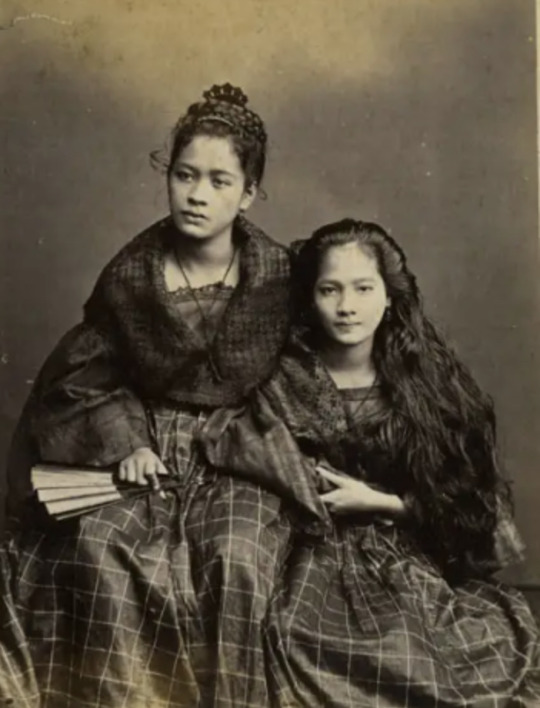
Two Young Women from Manila, Francisco van Camp. 1883.
#aesthetic#art#art history#fashion#historical fashion#historical art#women in art#women#victorian#victorian aesthetic#the philippines#filipino#Filipino history#photography#vintage photography#Manila#black and white photography#sepia photography#1880s#1880s aesthetic#1880s fashion#1880s hairstyles#1883
120 notes
·
View notes
Text
The Smithsonian has formed a task force to address the massive collection of human remains held by its museums, which includes 255 human brains that were removed primarily from dead Black and Indigenous people, as well as other people of color, without the consent or knowledge of their families. The so-called racial brain collection was revealed by a Washington Post investigation. It was mostly collected in the first half of the 20th century at the behest of Ales Hrdlicka, a racist anthropologist who was trying to scientifically prove the superiority of white people.
#anthropology#u.s. history#human remains#repatriation#eugenics#racism#black history#native american history#filipino history#anti indigenous violence#anti black violence#white supremacy
273 notes
·
View notes
Note
I was just curious but do you have any recs for period dramas about the philippines? I want to expand my period drama watching and im not quite sure where to start
Oh, the monster you've unleashed. YES I do have so many period dramas from and about the Philippines. Unfortunately, not all of them might be accessible to you if you're outside of the Philippines. Some of them are found on Amazon Prime, Netflix, and MUBI though. I'll make sure to put a lil note next to each film if they are. Also! these vary in genre (meaning: not all of them are war films, and some of these are horror films-- because this is me we're talking to, heh). I also have copies of some of these and will make a lil note next to each film if it's available for sharing, though I'll only give the link via DM. Please note, however, that they are all either in Tagalog, Bisaya, and/or other local Philippine Languages and not all of them have subtitles!
I also have very nuanced relationships with all these films, since Philippine History was my undergrad of choice. But to keep this post as brief as possible, I'm not going to talk about them at length. Though I will be including trigger warnings. Also note... some of these movies kinda suck HAAHAHAHA but I had way too much fun watching them so like. Please don't tell me they suck, please. I love them too much.
Also tagging @emmylynnaa because I promised her a similar list.
This is sorted by eras in Philippine History. Enjoy! (under the cut because it got long):
Spanish Occupation Era (1565 to 1898)
GomBurZa (2023) – A film following the GomBurZa, the three native Filipino Roman Catholic priests Gomez, Burgos, and Zamora executed during the latter years of the Spanish colonial era. TW: period typical violence. Furthermore, this is a Jesuit produced film so like. Once again. Take it with a grain of salt.
Jose Rizal (1998) - Jose Rizal's life and works are recounted through a series of non-linear flashbacks which reflect on various aspects of his life - as writer, propagandist, lover, friend, brother, doctor, and the man that inspired a revolution. Available on MUBI. TW: depiction of sexual assault by a priest. I also have a love-hate relationship with this film because on one hand, literally shaped my love of history. On the other hand, it is the MOST idealistic depiction of Jose Rizal ever + very historically inaccurate in many places, please watch this with a grain of salt.
Maria Clara at Ibarra (2022 – 2023) – A series about a girl from the 21st century who is magically transported into Jose Rizal’s famous novels Noli me Tangere and El Filibusterismo (you know, the novels that helped spark the Filipino Revolution against the Spanish). The synopsis sounds cheesy but trust me, it’s very good. Available to watch on the GMA official webpage. I just don’t know if you can access it outside of the country. TW: rape, abuses of the Catholic church, period typical violence, abuses of Spanish colonialists. A personal favorite—the costumes? Divine. And the character arcs are also really lovely. Helps you understand Philippine contemporary culture, too.
Katipunan: TV Mini Series (2013) – A mini-series depicting the creation of the Kataastaasan Kagalang-galang na Katipunan ng mga Anak ng Bayan (or the KKK—no, not the white supremacist group; that’s unfair, by the way, we did it first), the revolutionary organization founded in 1892 by Filipino Nationalists against Spanish Colonialization. Available to watch on the GMA official webpage. I just don’t know if you can access it outside of the country. TW: depictions of rape aftermath by Spanish soldiers, period typical violence, torture, graphic depictions of a corpse. This is a personal favorite of mine.
Hele sa Hiwagang Hapis/A Lullaby to the Sorrowful Mystery (2016) - Andrés Bonifacio is celebrated as the father of the Philippines Revolution against Spanish colonial rule. This eight-hour epic examines this myth, undertaking an expedition into history through various interwoven narrative threads, held together by an exploration of the individual’s role in history. Available on Mubi. TW: it is literally eight hours long. But that’s Lav Diaz for you. I love him, but oh my god is he an acquired taste.
Ang Kababaihan ng Malolos (2014) - The saga of the 20 Filipino women who petitioned for the opening of a school in a time when women weren’t given the chance to do so.
Ganito Kami Noon... Paano Kayo Ngayon? (1976) – Set during the end of Spanish colonization and the start of American colonization. After his mother's death, the simple-minded and naïve Kulas (Christopher De Leon) begins his much-awaited trip to Manila. On his way to Manila, he mindlessly takes on the mission of retrieving a friar's son and bringing him to the friar's residence.
Mallari (2023) - A horror film chronicling the deeds of the first recorded serial killer in the Philippines. This film spans decades, all the way up to present day. It's kinda stupid. Like. Really stupid. That's ok. We watch it because we want to see Piolo Pascual and JC Santos covered in blood. TW: oh my god so many bodies and so much gore.
Filipino-American War and America Occupation (1899 – 1940s) (this era has the best films, actually, if you want a place to start and start strong? start here)
Amigo (2010) - A local leader of a small Filipino barangay must decide whether to keep the peace with the American troops occupying his village or join the insurgency with his brother and son. TW: racism, sexual harassment, graphic depictions of corpses, gore, period typical violence.
Heneral Luna (2015) - Set during the Philippine-American war, Heneral Luna follows the life of one of Philippine History's most brilliant soldier, General Antonio Luna, as he tries to lead his countrymen against colonial masters new and old, and to rise above their own raging disputes to fulfill the promise of the Philippine Revolution. Available on Netflix. TW: short scene depicting the aftermath of sexual assault, period typical violence, and graphic depictions of a corpse. Again, one of my favorites. I have so many happy memories of this film + the fandom it birthed! I miss it sometimes.
Angelito (2018) – The short film that bridges both Heneral Luna and Goyo: Ang Batang Heneral, depicting the brothers Manuel and Jose Bernal – Antonio Luna’s aides-de-camp – and their youngest brother Angel, two days before the General’s assassination. This film you can find on Youtube!
Goyo: Ang Batang Heneral (2019) – The sequel of Heneral Luna, this film follows the story of Gregorio 'Goyo' del Pilar, one of the youngest Generals during the Philippine-American War who fought in the historic Battle of Tirad Pass. Available on Netflix. TW: short scenes of torture, period typical violence, and graphic depictions of a corpse. Again, a personal favorite for the same reasons stated above. Though it’s not as strong as Heneral Luna, I gotta say.
Ang Larawan (2017) - In a musical tale about standing together against materialism, two impoverished sisters anguish over whether or not to sell a painting, the final masterpiece by their recluse father. A bitter struggle for survival against betrayal set in pre-World War II Manila. A personal favorite, oh my god. This film. Oh my god, this film.
World War 2 and its aftermath (1940 – 1950)
Quezon’s Game (2018) - In 1938, Philippine President Manuel L. Quezon, military adviser Dwight D. Eisenhower, along with other notable figures, set out to rescue Jewish refugees fleeing Nazi Germany. Quezon simultaneously deals with a relapse of tuberculosis. Available on Amazon Prime. TW: talk of genocide and short scenes depicting the murder of Jewish people by the Nazis.
Tatlong Taong Walang Dios (1976) - A woman falls in love with a Japanese soldier during the Japanese Occupation in the Philippines; the whole town turns against her. TW: rape. Think Malena.
Oro, Plata, Mata (1982) - Set in the Philippine island of Negros during World War II, it tells the story of how two hacendero families cope with the changes brought about by the war. TW: rape
Kusina (2016) – Her kitchen. The silent witness to the life and love of Juanita. It is her sanctuary, the place where she creates dishes for her family, friends, even enemies and strangers. Through cooking, she gets to know the people around her. TW: violent child birth, death of mother in child birth, sexual harassment by Japanese soldiers. This spans multiple decades, all the way up to Martial Law.
In My Mother’s Skin (2023) - Stranded in the Philippines during World War II, a young girl finds that her duty to protect her dying mother is complicated by her misplaced trust in a beguiling, flesh-eating fairy. Available on Amazon Prime. TW: body horror, gore, explicit depictions of a corpse, period typical violence.
Markova: Comfort Gay (2000) – A coming of age drama film loosely based on the life of Walter Dempster Jr., the last surviving Filipino “comfort gay” (male sex slaves for the Imperial Japanese Army) from World War II. TW: CSA, wartime systemic rape, rape.
Comfort Women: A Cry for Justice (1994) – The story of how two sisters and the rest of the women of Sta. Monica are forced into sex slavery by Japanese soldiers during World War 2. TW: wartime systemic rape, rape, and period typical violence.
Seklusyon (2016) - In 1947, a group of deacons (aspiring priests) on their last week of training are sent to a remote monastery to live in seclusion for seven days to protect them from the devil, who on the last few days of training attempts to break the will of deacons to make them reconsider their choice of becoming priests. During their seclusion, a little girl named Anghela, believed by locals to be a living saint because of her healing abilities, appears at the monastery seeking refuge. Available on Amazon. TW: pedophilia, gore, body horror, Catholicism, religious horror.
Corazon: Ang Unang Aswang (2012) - A psychological thriller film detailing the psychological breakdown of a woman struggling with infertility in post-war Philippines. If you want to see women go feral, this is fun.
Martial Law (1970 – 1980) (actually, you know what? I lied. This era is the era with the best films. God, these are CLASSICS and are the ones that’ll help you understand contemporary Philippine culture the most; definitely start here)
Manila, sa mga Kuko ng Liwanag (1975) - Júlio Madiaga, a 'provinciano', arrives in Manila to search for his beloved, Ligaya. TW: coerced sex work, sexual abuse. Once again, a Filipino cinema classic.
Insiang (1976) - After a teenager is raped by her mother's boyfriend, she sets out to exact revenge on anyone who has hurt her. TW: I mean. It says it right there. Though it’s not actually shown on screen, it is very heavily implied. She doesn’t die in the end, if you’re wondering.
Dekada ’70 (2002) - A middle-class Filipino family struggles to survive in the era of dictatorship. This is a fucking classic in Filipino cinema. Available on MUBI. TW: sexual harrassment, discussion of torture, depictions of wounds and beatings, period typical violence. Martial Law was rough.
Aparisyon (2012) – A psychological drama film set in early 1970s, where the story about the nuns in the period immediately preceding the declaration of martial law by Ferdinand Marcos. The film’s director, Isabel Sandoval, is a transgender woman and an absolute visionary. Her other films Senorita (2011) and Lingua Franca (2019) are also very good, please check it out. All films are available for streaming through the Criterion Channel. TW: rape, religious trauma, period typical violence, Catholicism.
Lihis (2013) - Set in the 70’s during the darkest hours of Philippine History, we follow the story of two young NPA warriors who find themselves entangled in a web of frustration, despair and victory as they fight not only for democracy but also their love for each other. Available on MUBI. TW: Infidelity.
Barber’s Tales (2014) - In a rural town in the Philippines during the Marcos dictatorship, the newly widowed Marilou inherits the town's only barbershop from her husband- a business that has been passed down by generations of men in her husband's family. With no other means of support, she musters the courage to run the barbershop.
Dahling Nick (2015) - Dahling Nick is a docu-drama exploring the life and works of National Artist for Literature Nick Joaquin, who only accepted the National Artist Award on the condition that the Marcos administration release a well-known writer who was being unjustly detained during Martial Law. I love Nick Joaquin. He’s shaped my understanding of the Magical Realist genre far more than any of his contemporaries have. This film is notoriously difficult to get your hands on, so I suggest going to read his anthology by Penguin Classics called the Tropical Gothic instead!
Respeto (2017) - Hendrix is a poor aspiring rapper who wants to make a name for himself in the underground rap battle scene and gain respect in the community. After attempting to rob a second-hand bookstore in the neighborhood, he is discovered by the owner, Doc, an old poet with a haunted past as a dissident. Not necessarily period, but definitely has its roots in Martial Law.
Liway (2018) – A film about the kip, a young boy growing up in a prison as the son of anti-Marcos dissident Cecilia Flores-Oebanda, better known as Commander Liway, during the waning days of the Marcos dictatorship. It is currently streaming on Youtube!
The Kingmaker (2019) - is a 2019 documentary film written and directed by Lauren Greenfield, featuring the political career of Imelda Marcos with a focus on the Marcos family's efforts to rehabilitate the family's image and to return to political power, including her plans to see her son, Bongbong, become President of the Philippines, and the alliance that Bongbong and Imee Marcos established with Rodrigo Duterte in his bid to win the 2016 Philippine presidential election. Available on Youtube! if outside of the Philippines, use VPN.
1980s – 2000s Philippines
Misteryo sa Tuwa (1984) - The fortunes of three impoverished friends and their families abruptly change after an airplane crashes in a nearby mountain.
Alpha Kappa Omega Batch ’81 (1982) – A psychological drama film depicting the titular fraternity's harsh initiation of new batch members as seen through the eyes of pre-med student Sid Lucero. TW: hazing, torture, psychological torture. It’s fucked up, actually.
Himala (1982) – During a total eclipse Elsa, a young girl from rural Philippines, allegedly witnesses an apparition of the Virgin Mary on top of the hill where, as an infant, she was found and adopted by Saling. Said visions change her life and cause a sensation hysteria in a poor, isolated northern village in the midst of drought. TW: rape, religious fanaticism, religious trauma.
Adela (2008) - The story of Adela, which takes place in the span of one day, is a heartbreaking story of a woman who longs for the company of her loved ones. This isn’t actually period. This film just breaks my heart. And of course, it has acting legend Anita Linda in it. How could I not recommend it?
Now Showing (2008) - Rita is named after a famous American movie star whom her late, former actress grandmother once adored. She lives in one of Manila’s oldest districts with her mother and aunt. Years later, she is still the same girl enamoured with television, now tending to her aunt’s stall selling pirated DVDs.
Elegy to the Visitor from the Revolution (2011) - A woman from the end of the 19th century visits modern day Philippines and observes three interwoven stories: that of a prostitute, a group of criminals and a musician. This is another Lav Diaz one. It’s long.
K’na The Dreamweaver (2014) - K’na is a young woman coming into her own in the mountains of South Cotabato, where the T’boli live, overlooking the majestic and mystical Lake Sebu. She is part of the royal family of the South bank of the lake, part of the clan that was banished from the North Bank centuries ago after what the elders call The Great Betrayal. At a young age, K’na, is trained in the art of weaving the T’bolit’nalak. The design of the t’nalak fabric comes from the visions granted by Fu Dalu, the goddess of abaca, only to deserving women who become dreamweavers. K’na’s grandmother, Be Lamfey, is the village’s last master dreamweaver. When Be Lamfey dies, the gift of dreamweaving is passed to K’na and her father, LobongDitan, decides to put an end to the warring clans of Lake Sebu once and for all by arranging a marriage between K’na and Kagis, the heir to the throne of North bank. Meanwhile, K’na has fallen in love with Silaw, a childhood friend whose family supplies the finest abaca fibers to the dreamweavers. Silaw leaves love messages for her by tying bits of abaca thread to a tree outside K’na’s window. As the marriage grows near, a revolution brews among those who do not believe in the union of the two royal clans.
Smaller and Smaller Circles (2017) - Two Jesuit priests, Gus Saenz and Jerome Lucero perform forensic work to solve the mystery revolving around the murders of young boys in Payatas, one of Metro Manila's biggest slum areas. While dealing with the systematic corruption of the government, church, and the elite, the two priests delve into criminal profiling, crime scene investigation, and forensic analysis to solve the killings, and eventually, find the murderer. Available on Netflix. TW: child death, talk of child sexual abuse at the hands of the Catholic Church and at the hands of teachers, graphic depictions of a corpse, film also triggering to folks who suffer from claustrophobia.
Billie and Emma (2018) – An LGBT coming of age story set in the mid-1990s featuring two teenaged girls Billie and Emma as they grapple with topics such as sexuality, family, religion, unplanned pregnancy, and the uncertainty of the future.
#philippine cinema#filipino cinema#film recommendations#film rec#filipino period dramas#period dramas#philippine history#filipino history#please heed the tags there's a lot of violence in there#we have a very violent history
93 notes
·
View notes
Note
Hi, I want to ask if you have any topics about the Philippine-American War? I have gotten myself in Philippine History and I want to know deeper. Thanks:)
I was thinking of many ways on how to answer this because this is such a large and complicated topic but I could just try to summarize some stuff here and tell you what I know and what I could find.
The Filipino-American war mainly started as Filipinos felt betrayed by their former American allies after the country was sold to them by Spain after the Spanish-American war during the Treaty of Paris of 1898 for $20 million alongside other Spanish colonies like Puerto Rico, Guam, and Cuba (American Historical Association, n.d.). This feeling of betrayal had come from the fact that the leader and dictator president of the Filipino revolutionaries, Emilio Aguinaldo of the Kataastaasang Kagalang-galang Katipunan ng mga Anak ng Bayan (en. The Supreme and Honorable Association of the Children of the Nation) or the Katipunan for short, actually sought assistance from the Americans in Hong Kong during the Filipino Revolutionary War against Spain which was happening at the same time (Kedmey, 2013). This is why tensions were so high with the Americans when they first formally colonized the Philippines.
Interestingly, the purchase also included some territories that weren't actually part of Spanish rule such as the Sultanate of Sulu as well as some indigenous territories which led to a strained relationship with the Americans moving forward such as the independent Moros of Muslim Mindanao later being forced to assimilate to the rest of the colony of the Philippines despite previous agreements that state that they will leave them alone, mirroring the way the United States government treated Native Americans (Gowing, 1968).
Fighting between the American army and the Filipino army first broke out when on February 4, 1899 after Private William W. Grayson fired at 4 Filipino soldiers who cocked their rifles in response to them ordering the men to halt which later broke out into the Battle of Manile of 1899 (Chaput, 2012). As the Filipinos and Americans declared war on each other, the Katipuneros resorted to the mountains to start guerilla warfare against the American army (Philippine-American War, n.d.) which then lasted until 1901 when Aguinaldo was captured on March 23, 1901, just a day after Aguinaldo's birthday actually with the capture being attributed to two of his men, Lazaro Segovia and Hilario Tal Placido who betrayed him to the Americans with his other men still being too relaxed from the festivities the day before (Ocampo, 2010).
The fighting continued despite his capture and surrender until the last of the generals, General Macario Sakay, surrendered in July 14, 1906 who was then later executed along side his men on September 13, 1907 despite the initial promise of amnesty by the American government (Pangilinan & Pimintel, 2008).
The war ended the lives of 4,300 American soldiers with only 1,500 having been killed in action with the rest succumbing to diseases, while Filipino forces suffered 20,000 casualties alongside the death of 200,000 Filipino civilians due to hunger, disease, and combat (Philippine-American War, n.d.).
The violence of the situation and especially committed by the American soldiers prompted a lot of protests in the United States to stop the war immediately, as letters of the situation had been sent back to their homes which describes in excruciating detail the war crimes that these soldiers were ordered to commit such as blockading and burning down villages, extreme torture of captured and suspected enemies, and much more. The most well-known of these torture methods that I remember being taught to us in history classes as early as 4th grade was the "Water Cure" where American soldiers would force water down the victim's throat in and force them to vomit it back out. This article has a detailed account of the exact nature of this torture method as it discusses the torture of Mayor Joveniano Ealdama of Igbaras, who, although no American troop was actually hurt in his town, was tortured with his town being burnt down by the Americans the very next day (Vestal, 2017).
I do have to be honest, I was utterly shocked at how little Americans really knew about the Philippine American colonial era and by extension the Philippine-American war especially with the sheer amount of brutality the Americans had done to Filipino locals as well as the large impact the American government and American culture has had in my country and I am glad that more and more people are starting to learn more about this but it's still rather disappointing.
Videos on the Philippine-American War
If you want to learn more about the Philippine-American War, I have a couple of recommendations for videos that you can watch.
This video by Crash Course explains the origins of American Imperial idealization as well as the wars that led up to the colonization of the many territories that America acquired during this time era:
youtube
Here's a good summary by history teacher Mr. Beat of the major aspects of the war as well as the American public's perception of it that you can watch:
youtube
Here's a video made with a Filipino-perspective by Jonas Tayaban on the topic:
youtube
Here's a summary in Tagalog. It doesn't have English subtitles though but it does detail more things about the build-up and the subsequent wars between Spain and America and later the Philippines and Spain and then America too:
youtube
Movies about the Philippine-American War
I would also be remiss to not suggest some historical movies that tackle the events of this time period and especially TBA Studios' Artikulo Uno films Heneral Luna (2015) which focuses on the most popular and effective general of the revolution Gen. Antonio Luna, and Goyo: Ang Batang Heneral (2018) which focuses on Gregorio "Goyo" del Pilar, one the youngest generals of Filipino history who died a very tragic death at a young age:
youtube
You can watch the full movie here complete with English Subtitles
youtube
Another well-known movie about this time period is Viva Films' El Presidente (2012), although I had heard people say it's very much biased to the controversial dictator president Aguinaldo's side with many people citing that as the reason why they don't like the film.
youtube
Here's a reupload of the full-movie. It doesn't have subtitles though.
I don't know of any American-made movies that focuses on this topic and I know there's several other films that focus more on the politics of the Katipunan and the Filipino Revolutionary War against Spain, but not necessarily the Philippine-American War so if anyone has other suggestions, please let me know.
I would also like to suggest documentaries but most of the ones I've seen are on World War II and the others are other YouTube videos by history channels that I'm not too familiar with made by mostly white American YouTubers. Not that that would disqualify their videos (I did reference both John Green and Mr. Beat here) but I don't know these history channels and their hosts enough to recommend them in good faith as of right now.
Books and Further Reading on the Philippine-American War
For books on the subject, I often reference the many writings of Ambeth Ocampo such as his Looking Back series, specifically:
Looking Back 2: Dirty Dancing (Shopee, Lazada, Amazon)
Looking Back 11: Independence x6 (Shopee, Lazada)
Looking Back 13: Guns of the Katipunan (Shopee, Lazada)
I'm also currently interested in buying some other books about the topic like The Hills of Sampaloc: The Opening Actions of the Philippine-American War, February 4-5, 1899 (Shopee, Amazon) but I don't really have any extra money to spare for it right now.
I remember that my father had some other books about this too but the names had escaped me and it's far too much work to try to sort out through his entire book pile in our house.
I hope this answer's comprehensive enough since the subject is, as I said before, quite complex and rather large so I can't really get into all the specifics right now.
References:
American Historical Association. (n.d.). How Did America Enter the Picture?. Retrieved on 3 February 2024, from https://www.historians.org/about-aha-and-membership/aha-history-and-archives/gi-roundtable-series/pamphlets/em-24-what-lies-ahead-for-the-philippines-(1945)/how-did-america-enter-the-picture
Chaput, D. (2012). Private William W Grayson's War in the Philippines, 1899. Retrieved on 3 February 2024, from https://ne-test-site8.cdc.nicusa.com/sites/ne-test-site8.cdc.nicusa.com/files/doc/publications/NH1980GraysonWar1899.pdf
Gowing, P. (1968). Muslim-American Relations in the Philippines, 1899-1929. Retrieved on 3 February 2024, from https://asj.upd.edu.ph/mediabox/archive/ASJ-06-03-1968/gowing-muslim-american%20relations%20in%20the%20philippines%201899-1920.pdf
Kedmey, D. (2013, June 13). Exiled in Hong Kong: Famous Company for Edward Snowden.Time. Retrieved on 3 February 2024, from https://world.time.com/2013/06/15/exiled-in-hong-kong-famous-company-for-edward-snowden/slide/general-emilio-aguinaldo/
Ocampo, A. (2010). Looking Back 2: Dirty Dancing. Anvil Publishing
Pangilinan, F., & Pimintel, A. (2008, September 9). A Resolution Expressing the Sense of the Senate Honoring the Sacrifice of Macario Sakay and all other Filipinos who Gave Up their Lives in the Philippine-American War for our Freedom, Senate Resolution No. 623, 14th Congress of the Republic of the Philippines. Retrieved on 3 February 2024, from http://legacy.senate.gov.ph/lisdata/83927584!.pdf
Philippine-American War. In Britannica. Retrieved on 3 February 2024, from https://www.britannica.com/event/Philippine-American-War
Vestal, A. (2017). The First Wartime Water Torture by Americans. Retrieved on 3 February 2024, from https://digitalcommons.mainelaw.maine.edu/mlr/vol69/iss1/2/
#filipinfodump#filipino history#american history#history#filipino-american history#philippine-american war#military history#colonial history#imperialism#american imperialism#american colonization#american colonial era#philippines#america#filipino#katipunan#us military#president emilio aguinaldo#general antonio luna#general gregorio del pilar#filipino heroes#filipino presidents#john green#crash course history#crash course american history#mr. beat#jonas tayaban#moobly tv#filipino movies#heneral luna (2015)
78 notes
·
View notes
Text
So I'd like to talk a bit about the Filipino funeral gold scandal and how as someone writing an anti-colonial Filipino epic fantasy based heavily on early shaman lead rebellions against Spanish colonial rule I have some intense feelings about Filipino actress Beauty Gonzales flaunting wearing funerary death masks taken from a Large number of graves in surigao, butuan and mindinao and rather then treating them with appropriate respect or any kind of cultural ethics and instead turning them into fashion jewelry.

Aside from the damage to important archeological artifacts the utter disrespect shown to the dead who were interred in this way to ensure thier successful passage into the afterlife and to protect their bodies from the entry of evil spirits
For me it calls to mind when I was doing my primary sources research for Saints of Storm and Sorrow into the tree and boat burials of Luzon and reading the accounts of precolonial funerary practices by early Spanish friars and "naturalists" one of these documents was the memoir of Domingo Sanches who in a particularly horrifying account, noted how in the village he was staying in a young girl had died and he recorded how she was mourned and the great love and ceremony with which she was buried and how later that night he snuck back, dug up her grave and stole her body for research purposes. I remember he noted the great hostility of the natives when they discovered his theft and how he'd be unlikely able to return. I can't help being horrified at the thought of a Filipino actress adding to this horrible history of grave robbing and disrespecting the dead. To the colonialist mentality of taking spiritually important items and turning them into decorations. The level of disrespect is staggering. This is not the way to reconnect with our precolonial culture. I'm utterly horrified the more I look at this image and think about all the people who thought this was acceptable

For anyone interested in further reading
News articles citing art and museum critics disapproval
The screenshotted article with snippets from the Spanish naturalists memoir
History of funerary death masks and thier significance
#saints of storm and sorrow#Philippines#filipino#filipino culture#history#fashion#scandal#cultural artefacts#writing research#archaeology#colonialism#filipino history#filipino fashion#filipino author#grave robbery
158 notes
·
View notes
Text
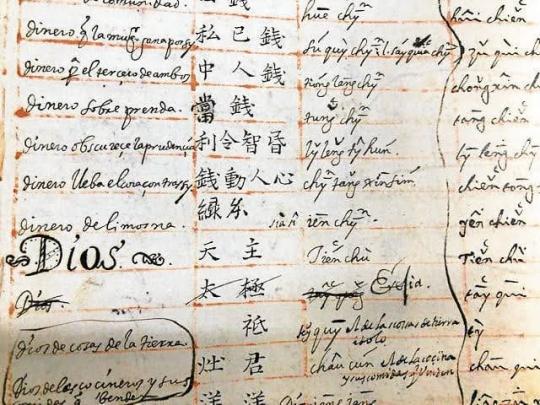
Oldest Spanish - Chinese dictionary found in University of Santo Thomas, Philippines. This 400 year old dictionary called “Dictionario Hispanico Sinicum” translated Spanish to Mandarin as well as Hokkien, a language from China's southern Fujian Province and spoken by many Chinese Filipinos.
#Hokkien#Filipino history#Chinese#Qing Dynasty#China#Fujian#Spanish#Hispanic#Philippines#Filipino#Filipinas#Español#Langblr#中文
51 notes
·
View notes
Text
Notes on Empire of Care by Catherine Ceniza Choy
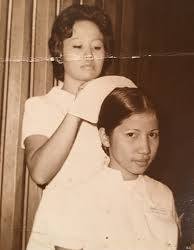
The scapegoating of Filipino nurse immigrants: Filipina Narciso and Lenora Perez are examples of two nurses who were scapegoated.
Filipino nurses with temporary work visas, H-1 visas, were exploited
Mass murder cases involving Filipino nurses included the 1996 Richard Speck massacre. Some of his victims were Filipino nurses and the only survivor was one of these Filipino nurses

The only survivor - Luisa Silverio
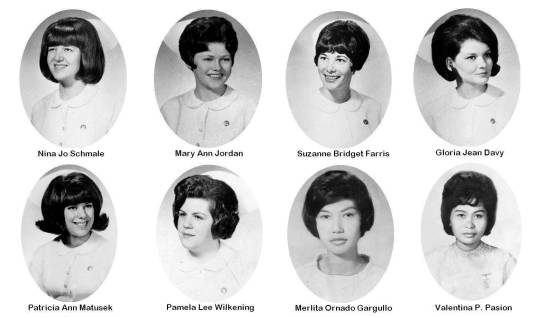
The victims
The 1975 Veterans administration hospital murders that happened in Ann Arbor, Michigan, and involved the previously mentioned nurses Narciso and Perez, bering initially convicted and then later acquitted. They were accused of poisoning and conspiracy
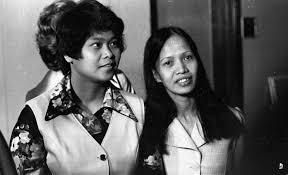
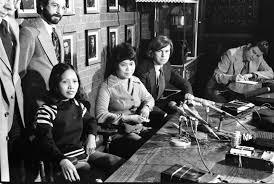
These cases reflect how US imperialism shaped the treatment that was levelled at Filipino nurses
During the late 1970s, Filipino nurse organisations emerged in order to combat the exploitation and discrimination that Filipino nurses faced
There is still a huge gap in the study of Filipino Americans. Quoted from Sucheng Chan's essay on Asian American historiography
"Despite the steady progress in Asian American historical scholarship, significant gaps remain. The most glaring is the absence of book-length studies on Filipino Americans"
American imperialism still shapes the way in which Filipinos - especially Filipino women are perceived
Jesse Ventura, an American politician in his autobiography "I ain't got no time to bleed" reminisces on his days as a Navy Seal stationed in the Philippines.
He talks about being young with a large libido, and how the abundance of Filipino women for him and his comrades to take home relieved that.
He spoke of going through less hurdles when he came to getting a Filipina to sleep with him compared to American women back home. In other words - Filipinas were easy.
This is a reflection of how US imperialism has shaped how the Philippines is viewed.
Filipino women are used in order to portray the Philippines as a feminised, hypersexual, always-willing paradise for the pleasure of Western men.
This depiction of so called "love" between Filipinos and Americans erases the long history of US violence, US domination, the colonial relationship between the US and the Philippines and the history of sexual violence perpetuated against Filipino women. Not to mention the destruction of the environment and spread of disease

US military presence in the Philippines also helped in influencing migration patterns.
By 1970, there were more Filipino men in the US navy than the Philippine navy. This was due to the active recruitment of Filipino men into the US military
Yet another example of how the US imperialist narrative erases truths about history and the lived experiences of Filipinos:
Filipino American organisations had to convince Minnesota legislature to correct a plaque commemorating the Spanish-American war.
The plaque stated that it was honouring the fact that the war was fought to free the Philippines from the tyrannical Spanish
This is unequivocally untrue and rings back to the concepts of American exceptionalism - The US being far more "benevolent" to it's colonies than their European counterparts.
The war was fought in order to defeat the Spanish - not to liberate the Philippines.
The Philippines then fought against the US for independence thereafter
America's so called "forgetfulness" when it comes to Filipino-American history continues to hurt Filipinos.
In particular, Filipino American war Veterans who struggle to fight for their access to veterans benefits.
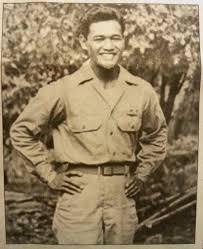

#the philippines#Philippines#Filipino#Filipino history#Philippine history#Pinoy#us imperialism#us colonialism#Us colonisation#U.S imperialism#U.S colonialism#U.S colonisation#American imperialism#American colonialism#American colonisation#Filipino American#Filipino American history#Asian history#South East Asian history#Colonialism#Imperialism#western colonialism#Western imperialism
102 notes
·
View notes
Text


Marina Summers for Unkabogaball 2022
#philippines#inspiration#fashionph#philippine culture#pinoypride#fashion#styleph#filipino#filipino fashion#filipino history#ph#philippine history#manila#drag queen#neverforget#martial law#marcos#philippine fashion
246 notes
·
View notes
Photo

These images were taken in the Philippines during the Spanish-American War, likely shortly before the start of the Philippine-American War, in 1898-99. They are part of an album that documents the experiences of Frank Freeman Atkinson, Sergeant in Battery D, US Army.
The Philippine-American War broke out when the United States annexed the Philippines after the Spanish–American War, which began when the Philippines revolted against Spanish rule, rather than acknowledging the Philippines' declaration of independence. The war resulted in over 200,000 Filipino civilian deaths, mostly due to disease and famine. Some estimates go as high as one million civilian deaths. After several delays, the United States eventually granted full Philippine independence in 1946 through the Treaty of Manila.
#AANHPI Month#AANHPI#AAPI Month#AAPI#Philippines#Filipino History#Philippine History#War#Photography#1890s#Libraries#Librarian
90 notes
·
View notes
Text
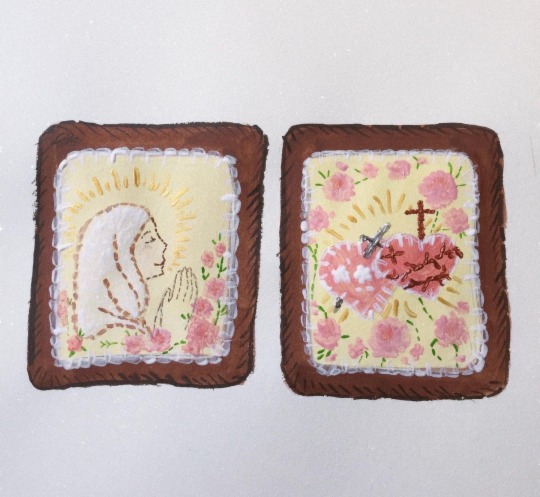
Eskapularyo, inspired by StellaMariGoldArt
The scapular was a popular garment of devotion to Filipinos during the Spanish Occupation. Nowadays, the miniature version of scapulars are mostly used by members of religious orders, as part of their habit. If noticed on documentaries and period films, the commoners used scapulars while the Ilustrados wore another version of it: the tambourine necklace (aka salasalamin), which are made of gold with a glass window containing relics of saints.
14 notes
·
View notes
Text
Simbang Gabi: The 9 Days Before Christmas

An image of a red parol from Peakpx.com
The Philippines is well-known for its extremely long Christmas celebration that a lot of foreigners often look at with confusion. Traditionally, Filipinos may start putting up their trees, playing festive songs, and counting down to the 25th as early as September in a season that's colloquially called the "ber months" or the "ber months season" (Petrelli, 2021). This period often lasts up until January or February where some houses may still keep their trees and decor pushing as far as March.
Even with this technicality, however, you'd be hard-pressed to find Filipinos truly celebrating from the very beginning of September genuinely ending it by the end of February. Most often, actual celebrations start after Undas, a period encompassing All Saints' Day and All Souls' Day on the 1st and 2nd of November respectively to commemorate the dead, similar but a lot more subtle than other Catholic countries own Day of the Dead like in Mexico's Dia de Los Muertos and Italy's Giorno dei Morti. This time period is often the start of people doing more Christmas-y things such as Kris Kringle activities leading up to the main Christmas party.
The main markers of the true start in itself is the Advent season, which starts on the Sunday nearest to the 30th in Western Churches like Roman Catholicism and leads up to Christmas ("Advent", n.d.). This is where Catholics would go to Church every Sunday leading up to Christmas to light the Advent Wreath until the final candle on its center on Christmas day on the 25th. As the Philippines is heavily influenced by Roman Catholicism, Filipinos follow the Western start of Advent and most celebrations often fall in the middle of this time period. Even the middle of Advent, however, Filipinos have a waiting period to count down before Christmas - Simbang Gabi.
What is Simbang Gabi?
Simbang Gabi (en. night mass; going to mass at night) is a Philippine Christmas tradition wherein Roman Catholic Filipinos would attend mass nine days every single morning or night before the actual Christmas celebration. Traditionally, the masses were held every morning at 4:00 AM from the 16th to the 24th which would then be capped off by Christmas Eve Mass at night or Christmas Mass on the 25th with its early schedule earning it the name Misa de Gallo (en. mass of the rooster) (Lazaro, 2020). In most dioceses, however, they often have an anticipated mass schedule that start a night earlier than the morning masses (Hermoso, 2022).
Besides being called Misa de Gallo, I had also heard the celebration being called Misa de Aguinaldo (en. mass of gifts) in some places. This shares the same name as the similar Puerto Rican tradition Misa de Aguinaldo which is also a nine-day mass held in the morning, typically at 5:00 AM which is also deeply-rooted in Puerto Rican Christmas traditions (Álvarez, 2018).
History
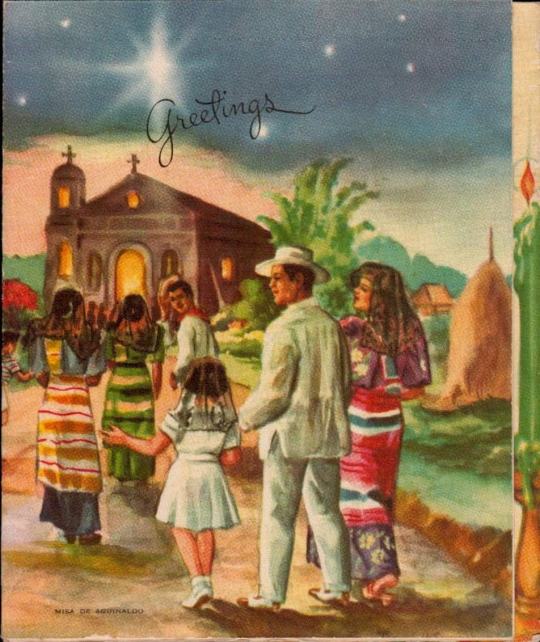
A vintage greeting card posted by the Facebook group Vintage Philippine Islands 1920-1959 (2020)
Being a Christmas tradition, it is not surprising that Simbang Gabi could trace itself back to the Spanish colonial period.
A common misconception of its origins states that the practice first started in Mexico. Hermoso (2018) states that it started on the year 1587 by Friar Diego de Soria of the Convent of San Agustin Acolman when he requested the Vatican to allow church service to be held outdoors because of an overflow of attendees during the Christmas time. Pope Sixtus V later approved of this request and even decreed that these kinds of masses be held in the Philippines at the dawn of the 16th of December. What this doesn't account for was that the practice of going to church for the Eve of Christmas dates back to even earlier than the 16th century.

The cover for an English translation and compilation of Etheria's writings by M.L. McClure and C.L. Feltoe, D.D. (1919)
The first recorded instance of Christians celebrating Christmas by going to early mass leading up to the actual date was first written by Egeria (also called Egeriae, Etheria, or Aetheria), a Christian Galician woman who first recorded it during her travels to the Levant where she notes the early morning masses and festivities from the time of the Epiphany to the Nativity. She writes in her letters later called the Itinerarium Egeriae (en. The Travel Guide of Egeria; The Pilgrimage of Etheria).
"Octave of the Festival.
On the second day also they proceed in like manner to the church in Golgotha, and also on the third day; thus the feast is celebrated with all this joyfulness for three days up to the sixth hour in the church built by Constantine (...) And in Bethlehem also throughout the entire eight days the feast is celebrated with similar festal array and joyfulness daily by the priests and by all the clergy there, and by the monks who are appointed in that place (...) and immense crowds, not of monks only, but also of the laity, both men and women, flock together to Jerusalem from every quarter for the solemn and joyous observance of that day."
- Egeria, 381-384; The Pilgrimage of Etheria (trans. McClure & Feltoe, 1919):
The practice of attending early morning masses up until the main festivities of the Nativity was later adopted by more Western Christian communties during the time of Pope Sixtus III when he celebrated what is widely considered the first Midnight Mass at the Basilica of St. Mary Major in Rome, not only stemming from the popularity of the Christians from Jerusalem but also the popular belief that Jesus was born at midnight (The Pillar, 2021).
The prayer spoken within the midnight vigil was then called the "mox ut gallus cantaverit" which translates to "when the rooster crows", aptly named because of the early hours the vigil tended to last which then coincided with the crowing of roosters ("Misa del Gallo: origen, historia y por qué se celebra en la madrugada del 25 de diciembre", 2022). The practice was continued by the Spanish with the name Misa de Gallo (also called Misa de Aguinaldo)which later spread throughout the Spanish Empire and could now be seen practiced in countries like Bolivia, Puerto Rico, Venezuela, and of course the Philippines.
There seem to be two variations of this: the nine-day series of masses before Christmas (found in the Philippines, Puerto Rico, and Venezuela) and the single early morning mass before Christmas day (found in Spain and Bolivia). It isn't clear if Spain and Bolivia simply dropped the nine-day tradition or if the nine-day tradition was restarted in these other colonies, however.
In the Present Day

An image of crowds outside a church during Simbang Gabi uploaded to Wikimedia by Erwin Malicdem
Today, the Simbang Gabi continues to be a popular tradtion for most Filipino Roman Catholics, even those who aren't typically as religious most parts of the year. This is given the fact that a popular belief is that when a person completes all of the nine days, they may receive a wish to whatever they desire. This is such a common belief that Bishop Broderick Pabillo, a Manila auxiliary bishop, had to remind people that the point of the tradition is to remember Jesus and his nativity (Punay, 2016). Besides this, it is also a common challenge among Filipinos to try to complete it as is or see how many days out of the nine could they actually attend.
It is not uncommon for churches these days to hold an "anticipated" mass the night before the actual date starting instead on the 15th and ending on the 24th with a Christmas mass, instead of starting on the 16th and ending on the 25th. This newer tradition had come from the reign of Filipino dictator President Ferdinand Marcos Sr. during the Martial Law years in the 70s, when Filipinos were not allowed to go out after a curfew until 4 in the morning (Macairan, 2023). This allowed more people and especially those who may not be able to start their day early or those who may have other obligations in the morning to attend masses at night time, typically at around 6 PM - 8 PM.
The only large controversy that I could remember about Simbang Gabi was back in 2011 when the event was banned from being conducted within the Philippine Center in New York City. The ban came about because of it supposedly violated Canon Law which prohibits religious worship in unconsecrated ground or in other words places that aren't seen as places of worship. In an article by Adarlo & Pastor (2014), Rev. Dr. Joseph G. Marabe, the at-the-time head of the Chapel of San Lorenzo Ruiz and a priest-in-residence at St. Patrick's Cathedral where the ban took place, explains in an interview with news site The FilAm:
"It’s not allowed by law to have Holy Mass in an unconsecrated place. Worship should take place in a sacred place. That was an explanation but not a decision. The Archdiocese decides."
- Rev. Dr. Joseph G. Marabe, head of the Chapel of San Lorenzo Ruiz in Chinatown, New York (2011)
The ban was later lifted on 2014 after community leader Loida Nicolas Lewis wrote a letter to the diocese to reconsider the ban which led to the return of the almost 30-year-old tradition that year (Balitang America, ABS-CBN North America Bureau, 2014).
Besides being a huge part of current traditions, a lot of Filipinos, and especially Filipino youth, use the event as an excuse to go out during the night to hang out with friends and even go on dates with their partners. It is not an uncommon sight to see a group of teenagers, often wearing maybe less than typical church clothes, by the edge of the Church seemingly attending mass. Whether or not they're actually being attentive is hard to decipher. Either way, this has led to an explosion of memes almost every year just mocking these kinds of people or making fun of their own.

A screenshot of the "Simbang gabi starter pack" posted by user rhapido on 9Gag.com (2022)
Earlier versions of this meme could be seen posted throughout Filipino social media during the early 2010s

A meme posted by the Facebook page FEU Memes (2012)
The barkada (en. friend group) going to Simbang Gabi had been an older tradition that has found a lot more popularity in the contemporary era because of social media. My mother had told me that she used to use it as an excuse herself back in the 80s to hang out with her friends at night time. This may be a continued past time for especially younger people for years to come.
There's also many street foods associated with Simbang Gabi that may not be unique to the event itself but are nevertheless heavily associated with the event due to their widespread sale during this time period. Foods like bibingka, puto bumbong, kutsinta, and other popular rice cakes dominate the scene which definitely satisfy the hungry parishioners who had, most likely, not eaten breakfast or dinner before going to church. With their strong associations with Simbang Gabii and Filipino Christmas as a whole, I might discuss these on a later date.
Simbang Gabi, from my experience
Growing up and living in the Philippines and especially being raised Catholic within a Catholic town named after a Catholic saint and going to a Catholic school named after another Catholic saint, it probably won't shock you that I, myself, had tried to complete the nine days of Simbang Gabi myself. I had attempted it several times with only maybe trying seriously by myself once in my life. It was quite the experience to just try to dedicate yourself into completing a goal to do something for nine consecutive days straight.
My first attempt was when I was in Junior High and it was with my sister and two people who worked for my parents and had helped watch over us. It was something that I always wanted to try doing and especially since I was gaining a lot more independence at the time so what better to try it out without the rest of the family? With adult supervision, of course.
Since we lived quite away from the actual church, the place was already packed even an hour before the actual mass started. There was barely any seats left and even less standing room leading to a huge overflow of people stuck outdoors, only hearing mass from the outdated speaker system that they had erected in place of the old bell tower.
The mass in our church was often done in the dark during the night out of an deliberate and probably aesthetic choice with only the alter being illuminated by the lights. The rest was lit up by the scattered about Christmas decor throughout the church and the church patio. It always felt like going to some liminal space that other nights at church just doesn't give.
Once the mass has been concluded, people rush out of the doors in thick crowds to find their way into the footpaths leading on to the main town streets. Some opt to stay behind to enjoy the food stalls that had pop-up for the night to eat bibingka, puto, sapin-sapin, and palitaw among other things. Some of the teens had decided to raid the nearby small park and playground as a hang-out spot to talk the night away before they rush home for their curfews. Meanwhile others were just rushing to get home as soon as they can, with people lining up to go to the rudimentary parking space that the church created while the others who didn't own their own vehicles forced to compete for the very few commuter vehicles still riding through the night, hunting for passengers.
This was before we had our own car, so we were with the latter crowds of people, trying to peer through the dark streets only illuminated by the scant Christmas lights that still refused to turn off as the night progressed. Every so often, two headlights excite the crowd and a swarm of them start running in anticipation with not care or tact if they would crush children or separate families all to take a seat on the night jeepneys, some the few commutes left after 9.
My sister was an expert in finding her way through it, reaching out to the doors to form a barricade for herself and the rest of us to prevent others from taking our seats before letting herself in. I still think I would've been left behind if it weren't for her doing that out of sheer competitiveness with the crowds.
We settled into our seats and squeezed in tightly to allow other passengers in so we could all go home as soon as we can. It was a tight but otherwise uneventful commute every night with nothing but tired people waiting for their stops and slowly emptying the once packed vehicle. Since we live in the outskirts of the town, we were often the last few and at times, the drivers would transfer us to other jeeps just so they can go home themselves. This had sometimes instead left us to walk the remainder of the way there through unpaved highway sidewalks.
After a few nights of it, I became more and more reluctant to continue because of the frenzy that it had almost every single night and it was extremely inconvenient for my time and the time of those with me. I didn't complete it then and I hadn't seriously tried until 9th Grade, which honestly was more uneventful.
That attempt was mostly my siblings and I staying in Makati City and Taguig City and going to easily traveled to churches that we could walk to by foot, and high-end malls that have annual Simbang Gabi masses for their shoppers, facilitated by the local diocese and the local fancy church. I was able to complete those easily because I was often dragged either by my siblings or my grandmother who used to never miss a day of church when she was still more active.
It was less about the challenge at that point and more of an obligation which isn't a bad thing and honestly is probably closer to how it should be celebrated.
I hadn't gone to Simbang Gabi since 2019 and I don't have any plans to try this year either. Not really because I don't want to necessarily, but specifically because I physically can't. I still think its pretty fun to do and honestly maybe a good excuse to meet with my friends that I haven't seen in a while. Sadly, I just simply cannot do it now nor in the near future.
Maybe one day I could once again go out at those cold December night to meet my friends and maybe eat some bibingka on my way home but I guess I'll just leave every one else to it.
Sources
Introduction
Advent. (n.d.). In Britannica. Retrieved on 13 December 2023, from https://www.britannica.com/topic/Advent
In The Philippines Christmas Eve Includes A Late Night Street Food Feast, Filipino Christmas, HD wallpaper [image]. (n.d.). Peakpx. Retrieved on 15 December 2023, from https://www.peakpx.com/en/hd-wallpaper-desktop-wxdle
Petrelli, M. (2021, December 20). The country that celebrates Christmas for more than 4 months a year. CNBC. Retrieved on 13 December 2023, from https://www.cnbc.com/2021/12/21/philippines-the-longest-christmas-celebrations-in-the-world-.html
What is Simbang Gabi?
Álvarez, F. (2018, November 22). Una tradición matutina la Misa de Aguinaldo. Primera Hora. Retrieved on 13 December 2023, from https://www.primerahora.com/noticias/puerto-rico/notas/una-tradicion-matutina-la-misa-de-aguinaldo/
Hermoso, C. (2022, December 15). 9-day ‘Simbang Gabi’ begins on Dec. 16; anticipated masses to begin tonight. Manila Bulletin. Retrieved on 13 December 2023, from https://mb.com.ph/2022/12/15/9-day-simbang-gabi-begins-on-dec-16-anticipated-masses-to-begin-tonight/
Lazaro, J. (2020, December 11). The Christmas tradition of Simbang Gabi: After five centuries, this Filipino Christmas tradition lives on. U.S. Catholic. Retrieved on 13 December 2023, from https://uscatholic.org/articles/202012/the-christmas-tradition-of-simbang-gabi/
History
Hermoso, C. (2018, December 15). ‘Simbang Gabi’ a manifestation of the Filipinos’ strong faith in God, says bishop. Manila Bulletin. Retrieved on 13 December 2023, from https://mb.com.ph/2018/12/15/simbang-gabi-a-manifestation-of-the-filipinos-strong-faith-in-god-says-bishop/
Etheria (1919). The Pilgrimage of Etheria (McClure, M., & Feltoe, C. Ed. & Trans.). Society for Promoting Christian Knowledge. Retrieved on 13 December 2023, from https://www.ccel.org/m/mcclure/etheria/etheria.htm (Original work published 384 C.E.)
McClure, M., & Feltoe, C. (1919). [An image of the book cover of "The Pilgrimage of Etheria"]. Retrieved on 15 December 2023, from https://www.ccel.org/m/mcclure/etheria/etheria.htm
The Pillar. (2021, December 21). What time is Midnight Mass?. The Pillar. Retrieved on 15 December 2023, from https://www.pillarcatholic.com/p/what-time-is-midnight-mass
Misa del Gallo: origen, historia y por qué se celebra en la madrugada del 25 de diciembre. (2022, December 24). Marca. Retrieved on 15 December 2023, from https://www.marca.com/tiramillas/actualidad/2022/12/24/63a6c106268e3e7c468b45e8.html
Vintage Philippine Islands 1920-1959. (2020, December 25). A Vintage Greeting Card showing Philippine Christmas… Maligayang Pasko from Vintage Philippine Islands 1920-1959 [image]. Facebook. Retrieved 15 December 2023, from https://www.facebook.com/510513375695362/photos/a.1701322009947820/3595821097164559/?type=3
In the Present Day
Adarlo, S., & Pastor, C. (2014, November 3). Fr. Joseph Marabe breaks silence over Simbang Gabi ban (Part 2). The FilAm: A Magazine for Filipino Americans in New York. Retrieved on 15 December 2023, from https://thefilam.net/archives/16127
Balitang America, ABS-CBN North America Bureau. (2014, September 19). Simbang Gabi returns to NYC after a brief ban. ABS-CBN News. Retrieved on 15 December 2023 from https://news.abs-cbn.com/global-filipino/09/19/14/simbang-gabi-returns-nyc-after-brief-ban
FEU Memes. (2012, December 15). eto yung mga madalas ko makita sa gilid ng simbahan e [image]. Retrieved on 15 December 2023 from https://www.facebook.com/PIYUMEMES/photos/a.210778985704527/317211885061236/?type=3
Macaira, E. (2023, December 15). Simbang Gabi: It’s the mass, not the time. Philippine Star. Retrieved on 15 December 2023, from https://www.philstar.com/headlines/2023/12/15/2318980/simbang-gabi-its-mass-not-time
Malicdem, E. (n.d.) The Bamboo Organ Church or the St. Joseph Parish Church of Las Piñas City in the Philippines during "Simbang Gabi" or Night Mass on Christmas eve. Photo was part of Schadow1 Expeditions coverage of Las Piñas during Christmas season. [image]. Retrieved on 15 December 2023 from https://en.wikipedia.org/wiki/Simbang_Gabi#/media/File:Las_Pinas_Church_during_Simbang_Gabi.jpg
Punay, E. (2016, December 19). ‘Simbang Gabi’ won’t grant wishes – Bishop. Philippine Star Global. Retrieved on 15 December 2023, from https://www.philstar.com/headlines/2016/12/19/1654920/simbang-gabi-wont-grant-wishes-bishop
rhapido. (2022, November 30). Simbang gabi starter pack [Screenshot]. 9Gag. Retrieved 15 December 2023, from https://9gag.com/gag/a5Xnzgr
#mayaposts#mayapino#philippines#filipino#history#philippine history#filipino history#christmas#filipino christmas#philippine christmas#simbang gabi#misa de gallo#misa de aguinaldo#long post#very long post#christianity#catholicism#roman catholic#christian history#food mention
21 notes
·
View notes
Text

"Dizon allows us to see a frontier of the Spanish imperium in a place that is not as commonly studied as the contours of Latin America. This allows us to get a different view of what Spanish colonials might have intended, but also of how local peoples responded to pressures on the land through their own active agency."
17 notes
·
View notes
Text
The Philippines is one of the most dangerous places in the world for journalists, but the threat, in my mind at least, was out in the provinces, where private armies and local officials operated with impunity. I was working for the largest television network and the highest circulated broadsheet in Manila. I also assumed, correctly as it turned out, that the assassination of a onetime national treasure would be more trouble than it was worth.
from Some People Need Killing: A Memoir of Murder in My Country, by Patricia Evangelista
#quotes#some people need killing#patricia evangelista#nonfiction#journalism#history#politics#crime#books#filipino history#filipino politics#filipino literature#filipino author
14 notes
·
View notes
Text
Historical inspiration for my fantasy novel: Pre-colonial Philippines
Seeker of the Lost Song is a historically-inspired fantasy novel merging medieval Finnish & pre-colonial Filipino elements, and I wanted to share two elements of Filipino history I included.
☼ 1) Dulang, a low table ☼
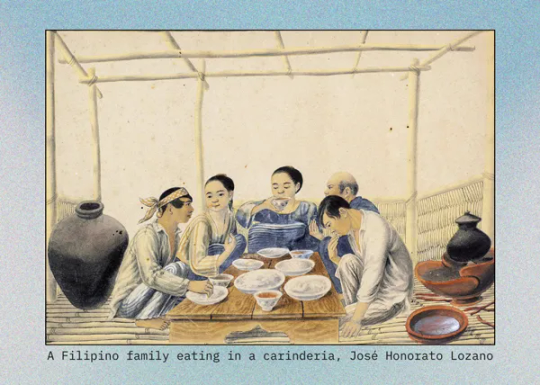
One of my favourite tidbits from my research is that pre-colonial Filipinos ate at a low table, sitting on the floor. Part of me worries that readers will think “Hey you stole that from Japan!” but I’m excited for the chance to show my people at their own low table, eating rice with their hands.
☼ 2) The balangay boat ☼

Another pre-colonial Filipino element I included in the book was a balangay, an ancient Filipino boat that’s recently come back into the public consciousness, with ancient boats being excavated and working replicas made. A quote from this article in STARweek, from one of the people who worked to rebuild the balangay, really resonated with me:
“It is very sad because we are a maritime people. We should be gifted and natural in the waters but colonialization robbed us of that consciousness. I am doing this to help rekindle that spirit”
The balangay that appears in my novel has a double outrigger (something that always feels so Filipino to me), but essentially it’s a larger version of the sketch pictured. And I have to admit, the scenes on the balangay did stir something in me. Something ancient and ancestral, perhaps?
Seeker’s as-yet-unnamed sequel also features elements of pre-colonial Filipino history, but more on that at another time. Suffice it to say I’m enjoying this opportunity to learn more about the history of my people and use it in a fantasy setting!
#amwriting#fantasy novel#seeker of the lost song#filipino history#canadian author#asian authors#southeast asia#precolonial philippines#asian fantasy#filipino fantasy
7 notes
·
View notes
Text
A form of Filipino Theater: Sarsuwela
(Pronounciation: Sar-swe-la)
A form of musical theater that has a heroic storyline and dramatic themes. Contains dance, poetry, and song. Severino Reyes(also known as Lola Basyang in 1925) is the father of Sarsuwela.
Pioneers of Sarsuwela in the Philippines:
Severino Reyes y Rivera(Feb 11, 1861 — Sep 15, 1942)
Hermogenes Ilagan(Apr 19, 1873 — Feb 27, 1943)
Juan Abad(Feb 8, 1872 — Dec 24, 1932)
Juan Crisóstomo Caballa Sotto(Jan 27, 1867 — July 12, 1918)(Pampanga‼️‼️)
Aurelio Tolentino y Valenzuela (Oct 15, 1869 — Jul 5, 1915)
The title of queen of Sarsuwela goes to Atang dela Rama/Honorata de la Rama-Hernandez(Jan 11, 1902 — Jully 11 1991)
#filipino culture#filipino history#Sarsuwela#zarzuela#severino reyes#lola basyang#theater#filipino theater#pampanga#kapampangan
6 notes
·
View notes
Text
Am I learning baybayin calligraphy to test a book theory for 1 historically accurate throwaway detail in SAINTS OF STORM AND SORROW? 🫣 Maybe?
And maybe I just spent 3 hours collecting banana leaves from a condemned apartment building, finding Tagalog Tanaga poems that fit thematically with my novel, SAINTS OF STORM AND SORROW translating the tagalog into baybayin symbols then testing writing implements and copying out 4 different sheets to be stored in different environments to test the long term legibility of said poems 🤣 that's also possible!
But in my defense nowhere on the internet was willing to tell me more than the Wikipedia single paragraph of yes South East Asia and the Philippines used banana leaves as a writing surface pre-colonization. So really this was for science. I will likely be writing up a full blog post detailing my recent adventure into historical recreation and banana leaves, once I've finished using all my extra banana leaves to make suman 😋
Happy Filipino American History month 🇵🇭
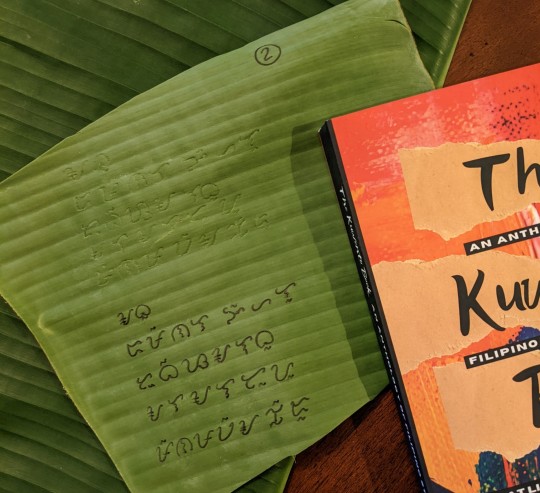
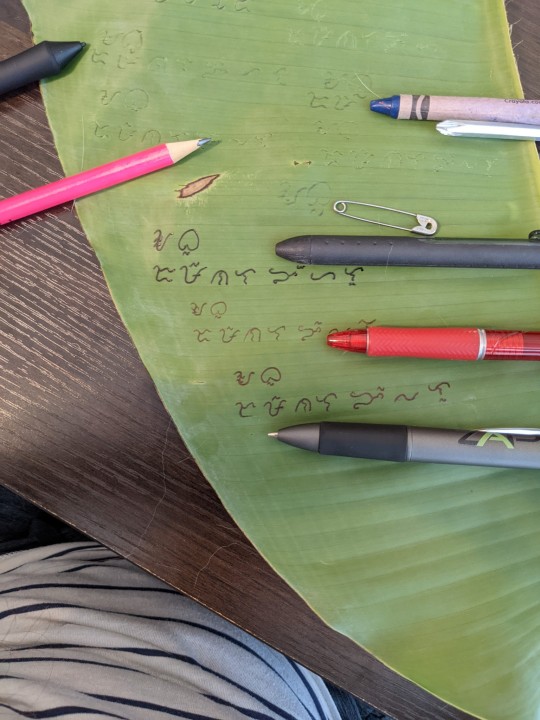
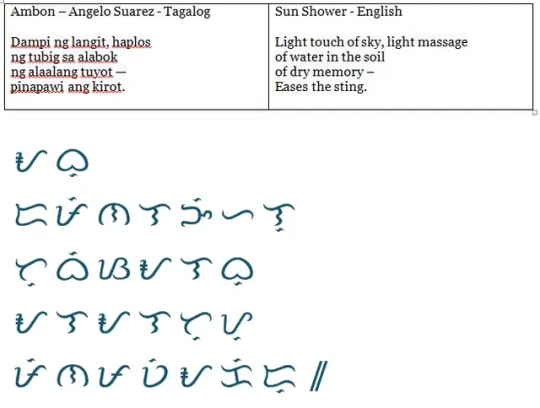
#baybayin#tagalog#filipino#poetry#Filipino history#writeblr#writing research#calligraphy#banana leaves#science#filipino fantasy#filipino author#poetry translation#FAHM
139 notes
·
View notes